
In 1997, Nightlight Christian Adoptions pioneered embryo adoption to assist families with remaining embryos in frozen storage in selecting an adopting family to attempt pregnancy with them.
They named their new program the "Snowflakes Embryo Adoption Program," likening each embryo to a unique, frozen snowflake. Snowflakes Embryo Adoption has since become the largest embryo adoption agency in the world.
Embryo adoption follows adoption best practices, transferring remaining embryos from donors to recipients—the adopting families—who then undergo frozen embryo transfers (FETs) with the embryos and give birth to their adopted child.
To ensure the well-being of all parties involved, an adoption home study is required. This process educates the adopting family and provides peace of mind to the embryo donors, knowing that the family receiving their embryos has been thoroughly vetted by the agency.
Embryo adoption programs differ from embryo donation programs run our of fertility clinics. While the latter primarily focus on medical treatment, adoption agencies consider social and emotional aspects for all involved in the adoption process.
Encouraging open relationships is a key aspect of embryo adoption, allowing children born from this process to maintain connections with both their biological background and their adoptive family's experiences. In contrast, embryo donation programs often prioritize anonymity, providing little to no information to either the donor or recipient and encouraging privacy rather than secrecy.
Many individuals opt to adopt embryos due to infertility diagnoses.
Although IVF success rates may seem high, they often do not encompass the diverse range of infertility issues couples may encounter. Research indicates that infertility diagnoses are equally divided: one-third due to female factors, one-third to male factors, and one-third remaining unidentifiable.
The sole medical prerequisite for participation in an embryo adoption program is the ability to carry and sustain a pregnancy, confirmed by a physician's letter stating the mother has no contraindications to do so.
Individuals who have successfully adopted embryos have various infertility factors, including:
Furthermore, some people choose embryo adoption simply because they are drawn to the idea and wish to expand their family, without necessarily facing infertility themselves.
There is often confusion regarding the nature of a human embryo.
To initiate the conception of a baby, the fusion of an egg cell and a sperm cell is required, a process known as fertilization. This union marks the creation of new life.
Each cell, whether egg or sperm, carries 23 chromosomes. Chromosomes, resembling thread-like structures, convey hereditary information such as traits related to hair, skin, and eye color. Composed of protein and a single DNA molecule, chromosomes contain the genetic blueprint of the embryo inherited from the parents.
In procedures like in vitro fertilization, eggs are extracted from the woman's body and sperm from the man's, and they are amalgamated within a laboratory setting to form embryos. Initially termed as a "test tube baby" when this method was pioneered.
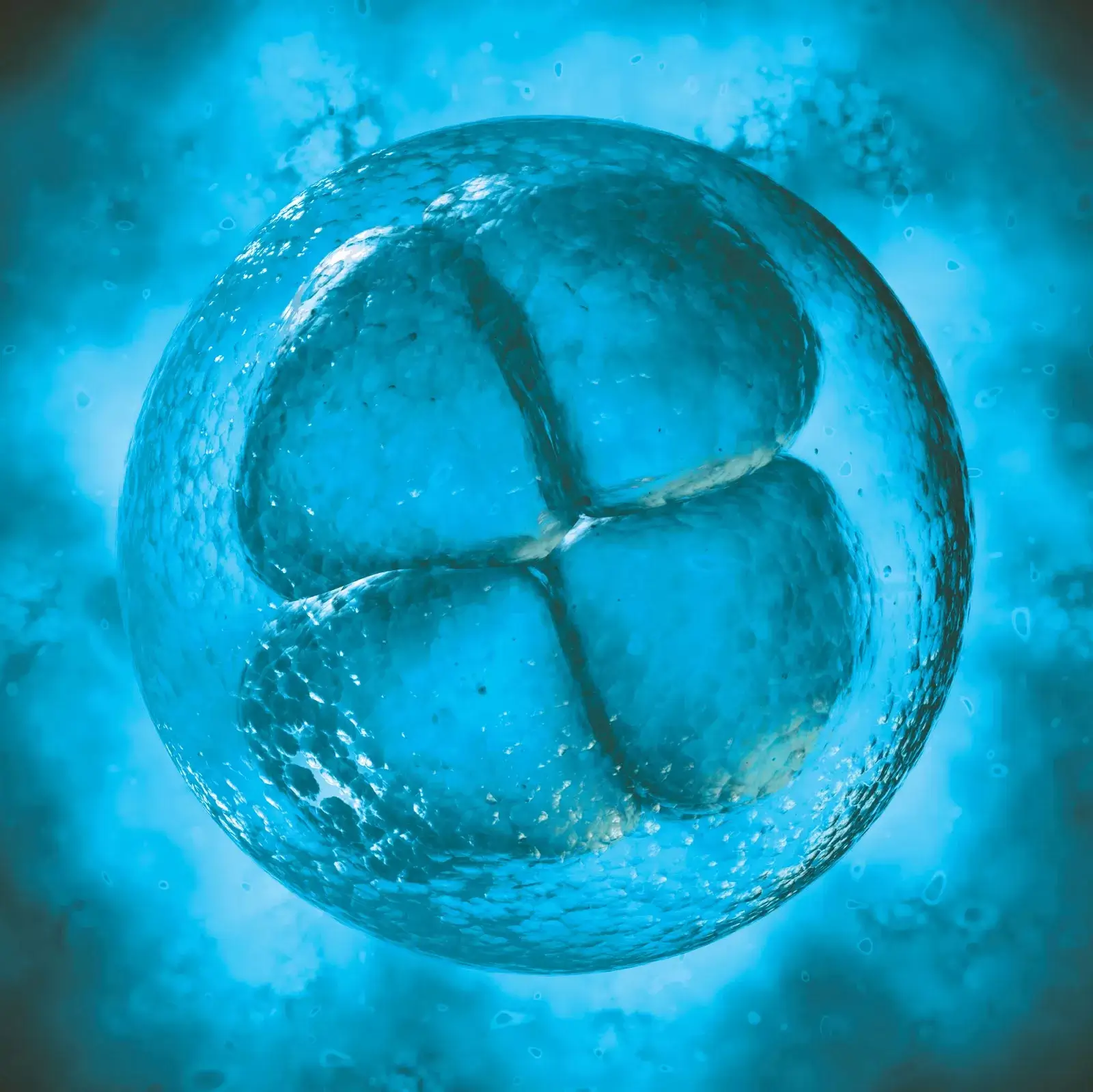
It is common for the in vitro fertilization process to yield more embryos than the family intends to utilize for their own pregnancy.
These surplus embryos are typically frozen and preserved either at the fertility clinic or within a cryobank. Eventually, a choice must be made regarding the disposition of these remaining frozen embryos.
Options include:
Embryo adoption closely parallels the adoption process of a newborn, except it starts approximately nine months earlier.
Embryos are created through a procedure known as in vitro fertilization (IVF). Often, more embryos are produced than a family is prepared for or able to bring to term. These "surplus" embryos are cryopreserved and stored, with over 1.5 million such embryos currently in frozen storage in the U.S.
If these families choose to donate the embryos, they can opt for either anonymous donation or select the recipient/adopting family via an embryo adoption program.
Upon finalization of the adoption process, the adopting family collaborates with a reproductive endocrinologist to undergo a frozen embryo transfer (FET). This involves thawing the embryos and transferring the viable ones. Should a successful pregnancy result, she will give birth to her adopted child.
The term "snowflake baby" originated with the Snowflakes Embryo Adoption Program. In this program, each adopted baby is assigned a sequential number. Presently, there are close to 1,300 Snowflake Babies born through the program!
Subsequently, other fertility clinics and organizations have adopted this term to refer to all babies born from donor embryos as "snowflake babies."
The success rate of embryo adoption, gauged by live births per embryo transfer, relies on various factors such as the quality of the embryo, the age of the egg donor, the quantity of embryos transferred, and the developmental stage of the embryo at the time of freezing.
Data sourced from the CDC indicates a live birth rate of 43-45% with embryo donation. Additionally, research studies indicate a higher success rate in achieving pregnancy using frozen embryos compared to fresh ones. It is estimated that the number of children born from frozen embryos likely surpasses 10,000.
While the current success rates of embryo adoption and donation are promising and expected to improve in the future, prospective adoptive couples should be aware of several factors influencing the likelihood of success:
1. The age of the donating mother at the time of egg retrieval: Fertility typically declines after the age of 35, affecting the quality of remaining eggs. Embryos created from eggs obtained from women aged 35 or older may have a reduced chance of successful implantation and development into a healthy baby. Many donated embryos originate from purchased human eggs retrieved from younger women.
2. The health status of the donating mother at the time of egg retrieval: Factors such as weight, smoking habits, and previous health issues can impact the health of the embryo.
3. The health status of the adoptive mother: Optimal health in the adoptive mother during the embryo transfer phase facilitates the body's adaptation to the changes necessary for a healthy pregnancy.
4. Timing of embryo freezing: Freezing embryos on day 5, at the blastocyst stage, is generally preferred by most clinics due to improved embryo health evaluation compared to earlier stages. However, successful births have occurred from embryos frozen as early as day 1. It's important to note that the donor family may already have children born from the same set of embryos.
5. The number of embryos available for thawing: While having more embryos increases the chances of success, it only takes one embryo to fulfill the dream of having a baby.
There is an increasing demand for donor embryos, as the cost of ART treatments and domestic infant and international adoption program fees continue to increase.
Some of these embryo adoption programs, like Snowflakes, adhere to adoption best practices, conducting home studies and carefully considering various factors during the matching process.
These factors may include:
Once a match is established, legal contracts are reviewed and approved by both parties, allowing for the shipment of embryos to the fertility clinic where the adopting family will undergo the frozen embryo transfer procedure.
Alternatively, when embryos are donated through fertility clinics, the medical staff often distribute multi-embryo sets among multiple waiting patients, ensuring broader access to donated embryos.
Additionally, there are embryo donor/recipient match websites designed to facilitate connections between families, each with its own procedures and limitations.
One of the first questions often posed is about the cost of embryo adoption.
Embryo adoption is classified within the realm of Assisted Reproductive Technologies (ART), encompassing various medical science treatments aimed at aiding conception. Donor embryos serve as a method within ART for achieving pregnancy.
Compared to other ART options, embryo adoption stands out as one of the more economical choices. Notably, unlike traditional adoption methods, embryo adoption affords the opportunity for the woman to undergo pregnancy and childbirth.
Conventional adoption procedures can incur costs amounting to tens of thousands of dollars. In contrast, a single round of IVF may range between $12,000 and $17,000. This expense can escalate significantly, potentially doubling or tripling based on the necessity for multiple egg retrievals and frozen embryo cycles to attain pregnancy.
A comprehensive overview of various ART treatments, adoption alternatives, and associated costs is provided in the accompanying infographic. On average, the total cost for embryo adoption typically falls within the range of $10,000 to $15,000, contingent upon the source from which the embryos are obtained.
Embryo adoption is an option available to families to help them achieve their dream of children. It also is a welcome choice to families who have remaining frozen embryos to choose life and an adopting family for their embryos.
Kelli Gassman always knew that when she had children, they’d be doted on by her little sister, Ericka. “If there was ever a baby in a room, Ericka was holding it. She was just that person,” she says.
Neither one of the siblings got the future she had planned on: Kelli struggled with infertility, and Ericka, at age 37, was diagnosed with breast cancer. “It was a hard time in my life,” says Kelli. “I was doubly grieving, seeing my sister get closer to her passing and knowing that the possibility of children seemed to be ebbing away for me.” Read the story.
Rodney and Mary Leah Miller couldn't conceive naturally. After six rounds of failed IVF, they learned about embryo adoption and donation through friends. They now have twins through embryo adoption and wish they had known about it sooner.
The Nix family went through embryo adoption twice and gave birth to two boys. Carrie said she always wanted to have kids, but knew she and Jimmy could not have biological children due to his genetic disease.
“There was 50 percent chance we would’ve passed it on,” said Carrie Nix. “We decided 50 percent was just too much.”
Embryo adoption was Carrie’s opportunity to experience pregnancy. It was Jimmy’s chance to keep his kids from going through the pain and medical procedures he has endured.
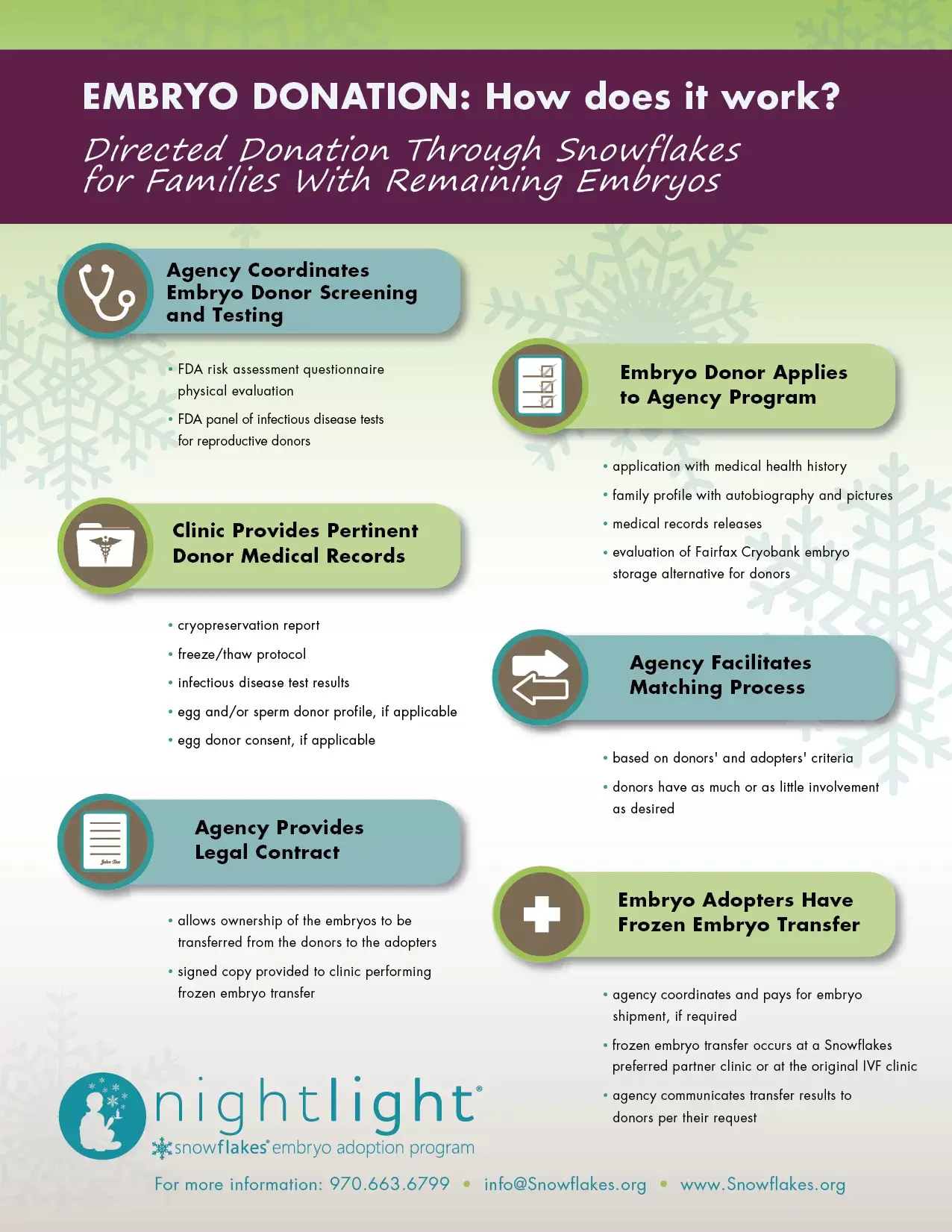
Embryo donation facilitated through an embryo adoption program alleviates the stress and uncertainty associated with finding recipient families for remaining embryos.
The Food and Drug Administration has established specific guidelines governing the donation of human embryos. Therefore, it's crucial to collaborate with an organization that adheres to these regulations and possesses relevant experience.
An embryo adoption program enables embryo donors to select the family to adopt the set of embryos. The program compiles a list of match preferences and mini family autobiographies from both donor and adopting families to facilitate a successful match.
Upon mutual agreement, all embryos within the donor's set are allocated to a single adopting family. This arrangement enables the adopter to pursue multiple pregnancy attempts without the need for additional embryo placements and affords the opportunity to give birth to genetic siblings.
Following the review and signing of legal contracts provided by the agency, the embryos are shipped to the adopting family's chosen fertility clinic, where an FET is scheduled.
The program keeps the donor informed about scheduled FETs and the birth of a baby. Encouraging both families to maintain an open relationship is emphasized, as it is deemed beneficial for the child's well-being. With services like 23andMe and social media readily accessible, locating siblings and parents is facilitated. However, it is preferable for such information to originate from the involved adults in the adoption process.
Fertility clinics in the U.S. report to the Centers for Disease Control regarding ART treatments performed at the clinic.
The chart to the right, from the most recent CDC ART Report, provides a breakdown of the types of IVF cycles performed in 2016.
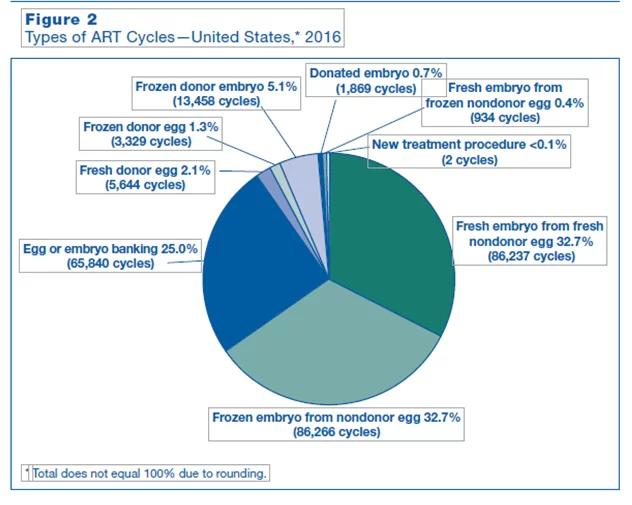
1. Answer to infertility struggles: Families who have undergone unsuccessful IVF treatments find success in embryo adoption and fulfill their dreams of parenthood.
2. Control over the prenatal environment: Adopting families have full knowledge and control of the prenatal care received, ensuring the developing baby is safeguarded from potential harmful exposures in utero.
3. Prenatal bonding: The excitement of pregnancy extends to spouses and extended family members, fostering prenatal bonding experiences such as baby showers, doctor check-ups, and preparing for the baby's arrival. Not to mention the chemical bonding between mother and baby during pregnancy.
4. Postnatal bonding and nursing: Unlike other forms of adoption, bonding between mother and child occurs immediately after the baby is born, with the biological process enabling nursing, providing the baby with essential medical benefits from colostrum and breast milk.
5. Medical flexibility: Various embryo adoption programs offer flexible options for medical care, including centralized locations or partnerships with clinics across the U.S. Some clinics even offer natural treatments for FET cycles, eliminating the need for hormonal drugs.
6. Security of placement: Upon contract signing, the adopting family assumes full control over the embryo set, ensuring security and stability throughout the process. Furthermore, the adopting mother's name is placed on the child's birth certificate alongside her husband's in all 50 states.
7. Ability to give birth to genetic siblings: Adopting a larger set of embryos allows families the opportunity for multiple FETs, potentially resulting in the birth of genetic siblings.
8. Diversity in embryo ethnicity: Embryo adoption offers embryos of various ethnicities, reflecting the diverse patient population undergoing IVF.
9. Reduction of frozen embryos: By opting for embryo adoption, couples contribute to reducing the number of embryos in frozen storage, addressing the issue of embryo surplus.
10. Cost-effectiveness: For couples requiring donor eggs or sperm, embryo adoption presents a more economical alternative, as many donated embryos are created using donor egg and/or sperm.
1. No guarantee of pregnancy: The biological process of pregnancy and childbirth cannot be guaranteed. There is a risk that embryos may not survive the freezing and thawing process, and a pregnancy may not result from an FET. While miscarriage can occur, it is usually at a lower rate than average. And birth defects can also occur, but not at any higher rate than in a naturally occurring pregnancy.
2. Potential need for multiple FET cycles:
Despite these drawbacks, the success rates for pregnancy through embryo adoption are promising, as reported by the U.S. Centers for Disease Control at 43-45%. In comparison, conception through non-medical methods typically yields success rates of only 20-25%.
In the early 2000s, embryonic stem cell research (ESCR) sparked significant controversy in the U.S.
Researchers believed that these cells, derived from human embryos, held the potential to unlock cures for various human diseases. It was widely understood that cells within the human embryo have the capability to develop into every cellular structure necessary for human development. However, a notable downside was that the embryos used in ESCR would be destroyed in the process. Furthermore, despite extensive research efforts, no successful therapies or cures have emerged from embryonic human stem cells.
On a more positive note, researchers and medical scientists have achieved considerable success using adult stem cells, often harvested from the recipient's own body for stem cell-based treatments. Over a million individuals have benefited from adult stem cell treatments, while ESCR has yet to yield any successful treatments.
Dr. James Thomson, a pioneer in the field of ESCR, once remarked, “If human embryonic stem cell research does not make you at least a little bit uncomfortable, you have not thought about it enough.”
On August 9, 2001, President George W. Bush addressed the ethics and federal funding fate of stem cell research from his ranch in Crawford, Texas. He announced the creation of a special council to oversee stem cell research, allowing ESCR but with limitations.
Five years later, on July 19, 2006, President Bush made history by signing his first veto, rejecting legislation passed by Congress that aimed to significantly expand federal support for embryonic stem cell research. Standing alongside the President were families who had welcomed children born from donated embryos. President Bush emphasized the sanctity of human life, stating, “Each of these human embryos is a unique human life with inherent dignity and matchless value.”

In his memoir "Decision Points," President Bush revealed his support for inviting a group of "snowflake babies" to the White House—a term referring to children born from frozen embryos that were instead implanted in adoptive mothers, rather than being destroyed for research.
In March 2009, President Barack Obama signed an Executive order revoking President Bush’s 2006 veto. This action prompted the National Institutes for Health to review and establish new guidelines for ESCR within 120 days. The Obama administration's policy permitted federally funded researchers to experiment on hundreds of viable ES cell lines previously restricted under Bush. This Executive Order opened the door to billions of dollars in additional taxpayer funds to support ESCR.
There are several options available to people who are looking for donated embryos to achieve a pregnancy.
Through an embryo adoption program
An embryo adoption program through an agency adheres to adoption best practices while facilitating the matching process between the adopting and the embryo donor families. In many cases, embryo adoption programs offer a wider selection of embryos, including larger sets.
Encouraging open relationships is a common practice among embryo adoption programs, as it is believed to be in the best interests of the children born from embryo donations.
Some embryo adoption programs charge a single, all-inclusive fee that covers administrative costs. This fee encompasses various services, including compliance with FDA regulations, acquisition of donor families, matching services, legal contracts, counseling, embryo shipment, and post-adoption support.
Other embryo adoption programs, while seemingly more cost effective, only offer limited or a la carte service models.
Through a fertility clinic
Not all fertility clinics in the U.S. offer internal embryo donation programs.
For those that do, there are often extensive waiting lists of patients seeking donor embryos, yet the supply of embryos may be insufficient to meet demand. This prolonged wait can be particularly frustrating, especially for intended parents of advanced age.
Fertility clinic donation programs essentially involve an FET and maintain a policy of anonymity. It's worth noting that IVF success rates can vary significantly from one clinic to another.
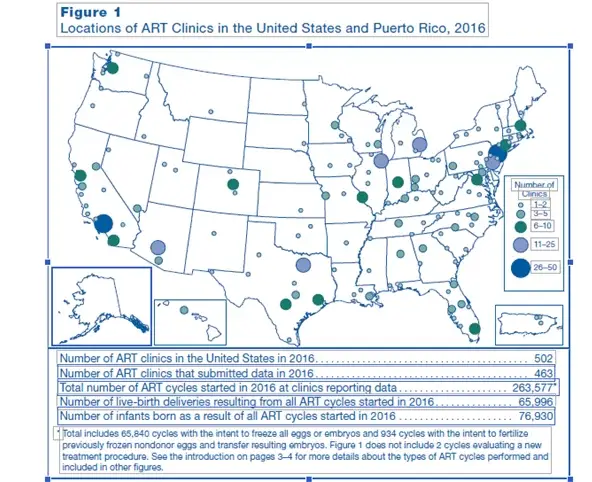
Fertility clinics that specialize in embryo donation
These clinics work diligently to attract embryo donors as their focus to help recipient families secure and give birth to children via embryo donation.
Primarily these specialized clinics are located in one location and the embryo
recipients must travel to that location for medical appointments.
There are a number of websites that facilitate helping donors meet recipients. Each of them operate uniquely.
Often the two parties have to coordinate matching, legal, embryo transport, and other aspects of the process themselves.
Curious about the average time it takes to conceive through embryo adoption?
Here's a breakdown of the rates of women who naturally conceive within a year of trying, categorized by age:
It's important to note that these figures represent averages, and there's no one-size-fits-all timeframe for conception. Every woman—and every couple—is unique, and various factors can influence fertility outcomes.
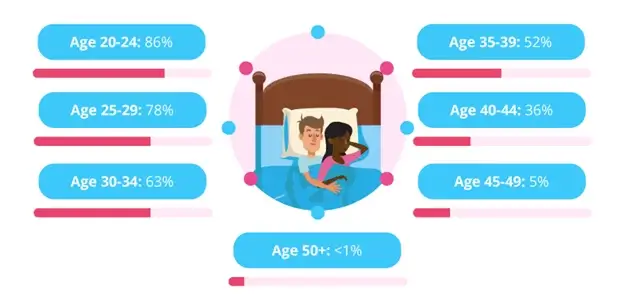
Legal documents pertaining to embryo adoption and donation are rooted in property law rather than adoption law, as embryos are considered property rather than individuals in the U.S federal government.
We are aware that the Alabama Supreme Court ruling has led many to have questions and concerns. The Snowflakes Team continues to serve both placing and adopting families in all states. To learn more about Nightlight’s stance on the ruling, you may read this blog written by our president, Dan Nehrbass, Ph.D., or contact a Snowflakes team member directly at info@snowflakes.org.
Adoption is a blessing, start your journey today.Get Started